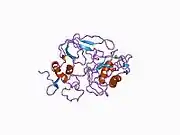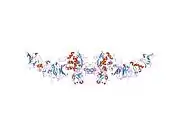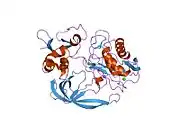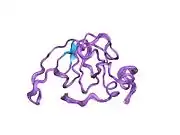TIMP2
Tissue inhibitor of metalloproteinases 2 (TIMP2) is a gene and a corresponding protein. The gene is a member of the TIMP gene family. The protein is thought to be a metastasis suppressor.
Function
The proteins encoded by this gene family are natural inhibitors of the matrix metalloproteinases (MMP), a group of peptidases involved in degradation of the extracellular matrix. In addition to an inhibitory role against metalloproteinases, the encoded protein has a unique role among TIMP family members in its ability to directly suppress the proliferation of endothelial cells. As a result, the encoded protein may be critical to the maintenance of tissue homeostasis by suppressing the proliferation of quiescent tissues in response to angiogenic factors, and by inhibiting protease activity in tissues undergoing remodelling of the extracellular matrix.[5] TIMP2 functions as both an MMP inhibitor and an activator. TIMPs inhibit active MMPs, but different TIMPs inhibit different MMPs better than others. For example, TIMP-1 inhibits MMP-7, MMP-9, MMP-1 and MMP-3 better than TIMP-2, and TIMP-2 inhibits MMP-2 more effectively than other TIMPs.[6]
In melanocytic cells TIMP2 gene expression may be regulated by MITF.[7]
A more recent discovery is that TIMP2 plays an important role in hippocampal function and cognitive function. It plays a critical role in the benefit conferred to old mice when given human umbilical cord blood.[8][9]
References
- GRCh38: Ensembl release 89: ENSG00000035862 - Ensembl, May 2017
- GRCm38: Ensembl release 89: ENSMUSG00000017466 - Ensembl, May 2017
- "Human PubMed Reference:". National Center for Biotechnology Information, U.S. National Library of Medicine.
- "Mouse PubMed Reference:". National Center for Biotechnology Information, U.S. National Library of Medicine.
- "Entrez Gene: TIMP2 TIMP metallopeptidase inhibitor 2".
- Bourboulia D, Stetler-Stevenson WG (Jun 2010). "Matrix metalloproteinases (MMPs) and tissue inhibitors of metalloproteinases (TIMPs): Positive and negative regulators in tumor cell adhesion". Seminars in Cancer Biology. 20 (3): 161–8. doi:10.1016/j.semcancer.2010.05.002. PMC 2941566. PMID 20470890.
- Hoek KS, Schlegel NC, Eichhoff OM, Widmer DS, Praetorius C, Einarsson SO, Valgeirsdottir S, Bergsteinsdottir K, Schepsky A, Dummer R, Steingrimsson E (2008). "Novel MITF targets identified using a two-step DNA microarray strategy". Pigment Cell Melanoma Res. 21 (6): 665–76. doi:10.1111/j.1755-148X.2008.00505.x. PMID 19067971. S2CID 24698373.
- Joseph Castellano; et al. (Apr 27, 2017). "Human umbilical cord plasma proteins revitalize hippocampal function in aged mice". Nature. 544 (7651): 488–492. doi:10.1038/nature22067. PMC 5586222. PMID 28424512.
- "Blood from human babies makes brains of elderly mice young again". New Scientist. Apr 29, 2017.
- Zucker S, Drews M, Conner C, Foda HD, DeClerck YA, Langley KE, Bahou WF, Docherty AJ, Cao J (January 1998). "Tissue inhibitor of metalloproteinase-2 (TIMP-2) binds to the catalytic domain of the cell surface receptor, membrane type 1-matrix metalloproteinase 1 (MT1-MMP)". J. Biol. Chem. 273 (2): 1216–22. doi:10.1074/jbc.273.2.1216. PMID 9422789.
- Morgunova E, Tuuttila A, Bergmann U, Tryggvason K (May 2002). "Structural insight into the complex formation of latent matrix metalloproteinase 2 with tissue inhibitor of metalloproteinase 2". Proc. Natl. Acad. Sci. U.S.A. 99 (11): 7414–9. doi:10.1073/pnas.102185399. PMC 124245. PMID 12032297.
- Overall CM, Tam E, McQuibban GA, Morrison C, Wallon UM, Bigg HF, King AE, Roberts CR (December 2000). "Domain interactions in the gelatinase A.TIMP-2.MT1-MMP activation complex. The ectodomain of the 44-kDa form of membrane type-1 matrix metalloproteinase does not modulate gelatinase A activation". J. Biol. Chem. 275 (50): 39497–506. doi:10.1074/jbc.M005932200. PMID 10991943.
- Bigg HF, Shi YE, Liu YE, Steffensen B, Overall CM (June 1997). "Specific, high affinity binding of tissue inhibitor of metalloproteinases-4 (TIMP-4) to the COOH-terminal hemopexin-like domain of human gelatinase A. TIMP-4 binds progelatinase A and the COOH-terminal domain in a similar manner to TIMP-2". J. Biol. Chem. 272 (24): 15496–500. doi:10.1074/jbc.272.24.15496. PMID 9182583.
- Kai HS, Butler GS, Morrison CJ, King AE, Pelman GR, Overall CM (December 2002). "Utilization of a novel recombinant myoglobin fusion protein expression system to characterize the tissue inhibitor of metalloproteinase (TIMP)-4 and TIMP-2 C-terminal domain and tails by mutagenesis. The importance of acidic residues in binding the MMP-2 hemopexin C-domain". J. Biol. Chem. 277 (50): 48696–707. doi:10.1074/jbc.M209177200. PMID 12374789.
Further reading
- Liotta LA, Stetler-Stevenson W, Steeg PS (1991). "Metastasis suppressor genes". Important Adv. Oncol.: 85–100. PMID 1869284.
- Stetler-Stevenson WG, Seo DW (2005). "TIMP-2: an endogenous inhibitor of angiogenesis". Trends in Molecular Medicine. 11 (3): 97–103. doi:10.1016/j.molmed.2005.01.007. PMID 15760767.
External links
- The MEROPS online database for peptidases and their inhibitors: I35.002
- Overview of all the structural information available in the PDB for UniProt: P16035 (Metalloproteinase inhibitor 2) at the PDBe-KB.











